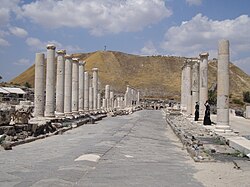Bet She'an
Beit She'an
|
||
|---|---|---|
| Hebrew transcription(s) | ||
| • ISO 259 | Beit Šˀan | |
| • Translit. | Bet Šəʼan | |
| • Also spelled | Bet She'an (official) Beth Shean (unofficial) |
|

Roman Cardo in Beit She'an National Park
|
||
|
||
| Coordinates: 32°30′N 35°30′E / 32.500°N 35.500°ECoordinates: 32°30′N 35°30′E / 32.500°N 35.500°E | ||
| District | Northern | |
| Founded | Around 5000 BCE | |
| Government | ||
| • Type | City | |
| • Mayor | Rafi Ben-Sheetrit | |
| Area | ||
| • Total | 7,330 dunams (7.33 km2 or 2.83 sq mi) | |
| Population (2015) | ||
| • Total | 17,332 | |
| Name meaning | House of Tranquillity | |
![]() Beit She'an (Hebrew: בֵּית שְׁאָן Beth Šəān; Arabic: بيسان,
Beit She'an (Hebrew: בֵּית שְׁאָן Beth Šəān; Arabic: بيسان, ![]() Beesān , Beisan or Bisan), is a city in the Northern District of Israel which has played historically an important role due to its geographical location, at the junction of the Jordan River Valley and the Jezreel Valley. It has also played an important role in modern times, acting as the regional center of the villages in the Beit She'an Valley.
Beesān , Beisan or Bisan), is a city in the Northern District of Israel which has played historically an important role due to its geographical location, at the junction of the Jordan River Valley and the Jezreel Valley. It has also played an important role in modern times, acting as the regional center of the villages in the Beit She'an Valley.
The ancient city ruins are now protected within a national park, known as Bet She'an National Park.
Beit She'an's location has always been strategically significant, due to its position at the junction of the Jordan River Valley and the Jezreel Valley, essentially controlling access from Jordan and the inland to the coast, as well as from Jerusalem and Jericho to the Galilee.
...
Wikipedia


